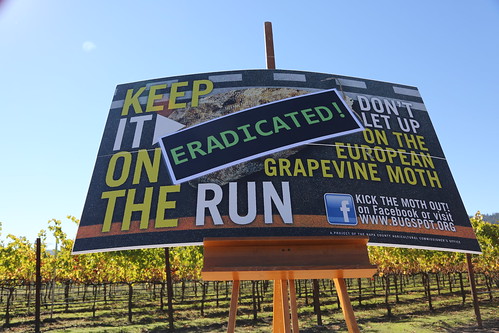
EGVM outreach sign used in Napa County that they can happily now retire, since the invasive pest has been eradicated. Photo by Nelly Castro, Napa County Agricultural Commissioner’s Office.
I was thrilled to celebrate with key partners and contributors in Napa County, California, recently at an event to recognize the critical safeguarding accomplishment we achieved together, that of eradicating the invasive European grapevine moth (EGVM) from the United States.
Leaders from the USDA, Animal and Plant Health Inspection Service (APHIS), the California Department of Food and Agriculture (CDFA), and the California County Agricultural Commissioners came together with growers and industry representatives, who found and implemented the right tools to safeguard California grapes. In front of these critical partners, I was proud to recognize the extraordinary individual and group contributions that made the eradication of EGVM possible.
The keys to success were early detection, our rapid response, and a strong collaboration between federal, state and local officials, growers, university scientists and extension services. Such partnerships remain critical to our ability to safeguard agriculture and facilitate safe trade.
EGVM was first detected in a Napa Valley vineyard in 2009. Subsequent surveys detected the moth in 11 California counties, seriously threatening California’s $4 billion grape crop, a crop which also generates more than $57 billion annually for the State. The pest also jeopardized valuable export markets for U.S. grapes, as well as for stone fruit, another EGVM host.

Left to right: Osama El-Lissy, APHIS Deputy Administrator; U.S. Representative Mike Thompson; Greg Clark, Napa County Agricultural Commissioner; and Bob Wynn, CDFA’s Statewide Coordinator for Pierce's Disease Control Program. Photo by Tony Pugliani.
Congressional support and funding was another critical element to EGVM program success. California U.S. Representative Mike Thompson was at the event to thank partners for protecting the grape industry and California’s agricultural economy. “From the $65 million in federal funding that I was proud to help secure, to the extensive surveying and regulatory work done by state officials, to the research and development of the pheromone that kept these moths from mating, to our growers who cooperated with control efforts – the eradication of the European Grapevine moth was a team effort in every sense,” he told the assembled group.
That team included a Technical Working Group of scientific and technical experts from the U.S. government, universities in California, Italy, and Chile, and the California grape industry. With their help, APHIS and its partners had the best available science and data with which to design an eradication program that produced results by closely involving growers and the community.
In fact, CDFA Secretary Karen Ross told us that the growers and their communities deserve the lion’s share of the credit for eradicating the EGVM. She said, “They formed and sustained the cooperative effort with our agencies that ultimately achieved this goal. We are gathering to celebrate this mutual achievement, but perhaps more importantly we are here to say how proud we are of the partnership that got us here – a partnership that remains ready to respond to the next threat to venture into our vineyards.”
And she is right. APHIS, the grape industry, the State of California, county, universities, and our fellow Federal cooperators will remain vigilant by continuing to monitor for EGVM and other grape pests.

The three partners in the EGVM eradication program, USDA APHIS Plant Protection and Quarantine, the California Department of Food and Agriculture, and County agricultural commissioners are represented by these leaders (left to right): Beth Stone-Smith, APHIS EGVM Field Program Manager; Greg Clark, Napa County Agricultural Commissioner; Dave Whitmer, former Napa County Agricultural Commissioner; Helene Wright, APHIS California Plant Health Director; Karen Ross, California Secretary of Food and Agriculture; Osama El-Lissy, APHIS Deputy Administrator; Elvis Cordova, USDA Acting Under Secretary of Marketing and Regulatory Programs; and Mike Gregoire, APHIS Associate Administrator. Photo by Tony Pugliani.
No comments:
Post a Comment
Note: Only a member of this blog may post a comment.